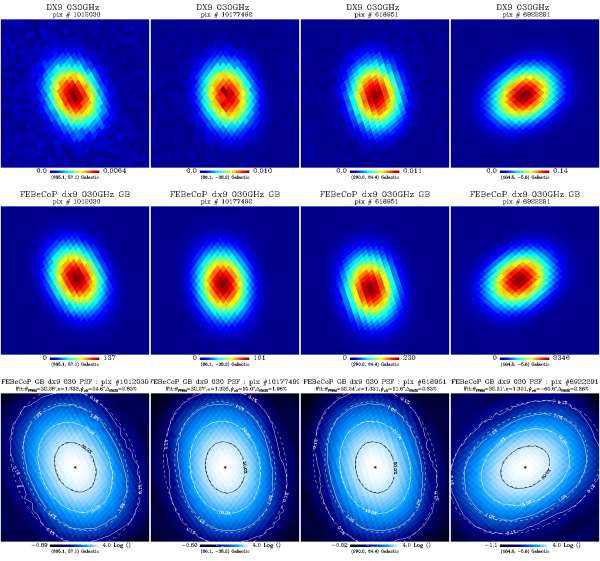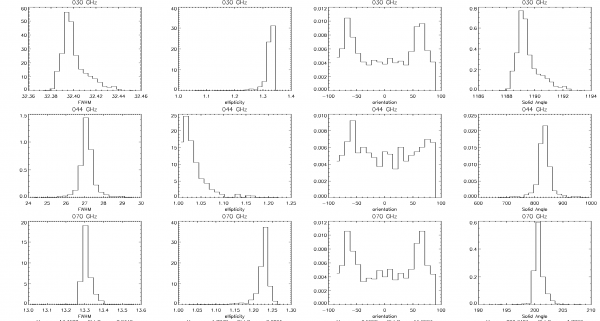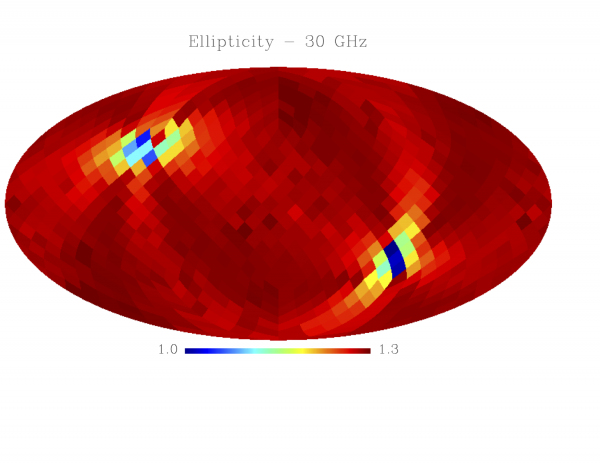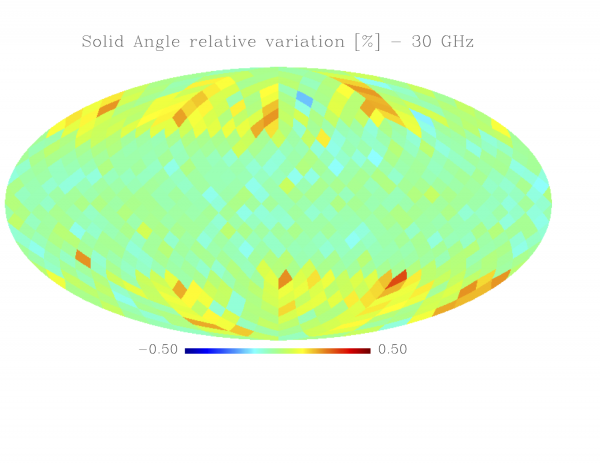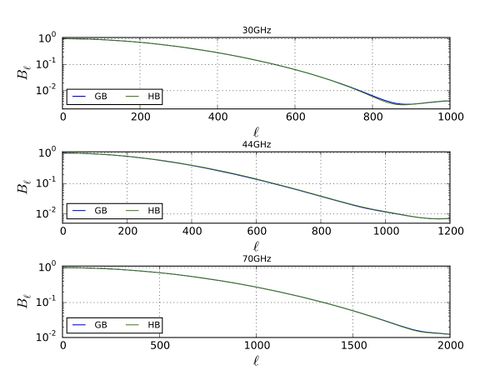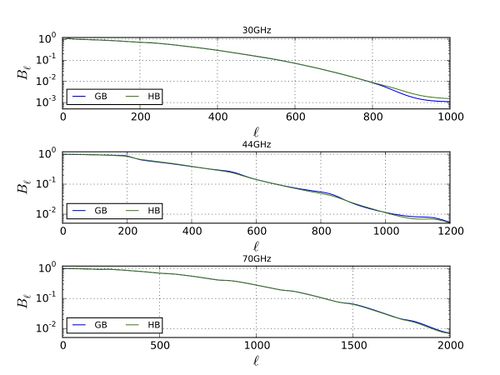Beams
Contents
[hide]- 1 Overview
- 2 Beam Normalization
- 3 Polarized Scanning Beams and Focal Plane calibration
- 4 Effective beams
- 4.1 Production process
- 4.2 Inputs
- 4.3 Comparison of the images of compact sources observed by Planck with FEBeCoP products
- 4.4 Histograms of the effective beam parameters
- 4.5 Sky variation of effective beam solid angle and ellipticity of the best-fit Gaussian
- 4.6 Statistics of the effective beams computed using FEBeCoP
- 4.7 Related products
- 4.8 Monte Carlo simulations
- 5 Window Functions
- 6 Sidelobes
- 7 References
Overview[edit]
LFI observed the sky with 11 pairs of beams associated with the 22 pseudo-correlation radiometers. Each beam of the radiometer pair (Radiometer Chain Assembly - RCA) is named as LFIXXM or LFIXXS. XX is the RCA number ranging from 18 to 28; M and S are the two polarizations, namely the main-arm and side-arm of the Orthomode transducers [1] (see also LFI naming convention).
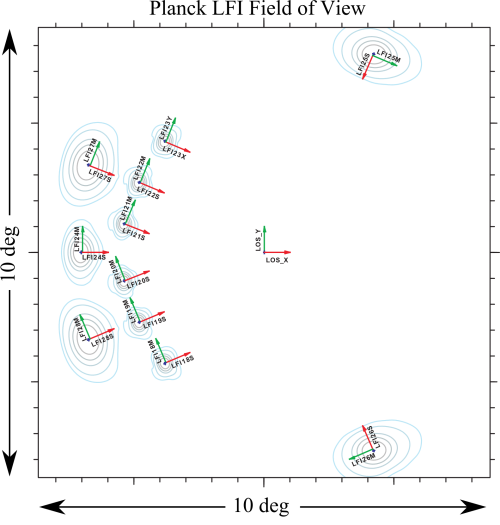
Details are given in Planck-2015-A04[2]. Please note that many figures below refer to the previous Planck release Planck-2013-IV[3] since they have not changed significantly.
Beam Normalization[edit]
With respect to the previous release, the beam normalization convention adopted in the LFI pipeline has changed. In previous work, the main beam used in the calculation of the effective beams (and effective beam window functions) was a full-power main beam (i.e unrealistically set to 100% efficiency). The resulting beam window function was normalized to unity because the calibration was performed assuming a pencil beam. This assumption provides that all the power entering the feed horn comes from the beam line of sight. We know that this assumption is not realistic, since up to 1% of the solid angle of the LFI beams falls into the sidelobes, unevenly distributed and concentrated mainly in two areas: the main and sub spillover.
We now employ full 4pi beams. Important to note is that the roughly 1% of the signal found in the sidelobes is missing from the vicinity of the main beam, so the main beam efficiency η ≈ 99%; and this must be accounted for in any analysis of the maps. In particular, the window function used to correct the power spectra extracted from the maps (which is based on the main beam only) allows for this efficiency.
Details are given in Planck-2015-A04[2].
Polarized Scanning Beams and Focal Plane calibration[edit]
Focal plane calibration is based on the determination of the beam pointing parameters in the nominal Line of Sight (LOS) frame derived from measurements during Jupiter transits. The parameters that characterise the beam pointing are the following:
- THETA_UV ()
- PHI_UV ()
They are calculated starting from u,v coordinates derived form the beam reconstruction algorithm as
Two additional angles are used to characterize the beams in the RIMO:
- PSI_UV ()
- PSI_POL ()
and are not derived from measurements, but rather are estimated from optical simulations. They are the quantities that represent the polarization direction of each beam, assuming that the M- and S- beams of the same RCA point at the same direction on the sky.
The polarized scanning beams were evaluated from optical simulations using the GRASP Physical Optics code, by appropriately tuning the Radio Frequency Flight Model (RFFM) Planck-PreLaunch-XII[4].
The Radio Frequency Tuned Model, called RFTM, was implemented to fit the in-flight beam measurements with an electromagnetic model. The LFI main beams can be considered linearly polarized, but the non-null cross-polarization has an impact on the polarization measurements. Since we are not able to measure the cross polar beam in flight, we have relied on simulations validated by accurate beam measurements.
The model beams were monochromatic and were computed at various frequencies throughout a 6 GHz band around the Optical Center Frequency (OCF) with non-uniform steps (denser sampling where the band-pass was higher). For the RFTM model the OCF were set at GHz.
For each simulated beam we created a map of the Stokes polarization parameters. On those maps we performed a weighted in-band average to recover our best estimation of the polarized beam shape. The weighting function was the RIMO transmission function.
The delivered products include the in-band averaged Stokes scanning maps of main beams, intermediate beams and sidelobes.
Effective beams[edit]
The effective beam is the average of all scanning beams pointing at a certain direction within a given pixel of the sky map for a given scan strategy. It takes into account the coupling between azimuthal asymmetry of the beam and the uneven distribution of scanning angles across the sky. It captures the complete information about the difference between the true and observed image of the sky. They are, by definition, the objects whose convolution with the true CMB sky produce the observed sky map.
The full algebra involving the effective beams for temperature and polarisation was presented in [5]. Here we summarise the main results. The observed temperature sky is a convolution of the true sky and the effective beam :
where
labels the time samples, is if the pointing direction falls in pixel number , else it is , represents the exact pointing direction (not approximated by the pixel centre location), and is the centre of the pixel number , where the scanbeam is being evaluated (if the pointing direction falls within the cut-off radius of FWHM.
The algebra is a bit more involved for polarised detectors. The observed stokes parameters at a pixel , , are related to the true stokes parameters , by the following relation:
where the polarised effective beam matrix
and and are the the polarisation weight vectors, as defined in \cite{mitra2010}.
The task is to compute for temperature only beams and the matrices for each pixel , at every neighbouring pixel that fall within the cut-off radius around the the center of the pixel.
The effective beam is computed by stacking within a small field around each pixel of the HEALPix sky map. Due to the particular features of Planck scanning strategy coupled to the beam asymmetries in the focal plane, and data processing of the bolometer and radiometer TOIs, the resulting Planck effective beams vary over the sky.
FEBeCoP, given information on Planck scanning beams and detector pointing during a mission period of interest, provides the pixelized stamps of both the effective beam, EB, and the Point Spread Function, PSF, at all pixel-centre positions of the HEALPix-formatted map.
Production process[edit]
The methodology for computing effective beams for a scanning CMB experiment like Planck was presented in [5].
FEBeCoP, or Fast Effective Beam Convolution in Pixel space, is an approach to representing and computing effective beams (including both intrinsic beam shapes and the effects of scanning) that comprises the following steps:
- identify the individual detectors' instantaneous optical response function (presently we use elliptical Gaussian fits of Planck beams from observations of planets; eventually, an arbitrary mathematical representation of the beam can be used on input)
- follow exactly the Planck scanning, and project the intrinsic beam on the sky at each actual sampling position
- project instantaneous beams onto the pixelized map over a small region (typically <2.5 FWHM diameter)
- add up all beams that cross the same pixel and its vicinity during the period of interest
- create a data object of all beams pointed at all N'_pix_' directions of pixels in the map at a resolution at which this precomputation was executed (dimension N'_pix_' x a few hundred)
- use the resulting beam object for very fast convolution of all sky signals with the effective optical response of the observing mission
Computation of the effective beams at each pixel for every detector is a challenging task for high resolution experiments. FEBeCoP is an efficient algorithm and implementation which enabled us to compute the pixel based effective beams using moderate computational resources. The algorithm used different mathematical and computational techniques to bring down the computation cost to a practical level. That allowed several estimations of the effective beams for all Planck detectors for different scan and beam models as well as datasets of different length.
Pixel Ordered Detector Angles (PODA)[edit]
The main challenge in computing the effective beams is to go through the trillion samples, which gets severely limited by I/O. In the first stage, for a given dataset, ordered lists of pointing angles for each pixel---the Pixel Ordered Detector Angles (PODA) are made. This is an one-time process for each dataset. We used computers with large memory and used tedious memory management bookkeeping to make this step efficient.
effBeam[edit]
The effBeam part makes use of the precomputed PODA and unsynchronized reading from the disk to compute the beam. Here we tried to made sure that no repetition occurs in evaluating a trigonometric quantity.
One important reason for separating the two steps is that they use different schemes of parallel computing. The PODA part requires parallelisation over time-order-data samples, while the effBeam part requires distribution of pixels among different computers.
Computational Cost[edit]
The whole computation of the effective beams has been performed at the NERSC Supercomputing Center. In the table below we display the computation cost at NERSC for the nominal mission both in terms of CPU hrs and in human time.
| Channel | 030 | 044 | 070 |
| PODA/Detector Computation time (CPU hrs) | 85 | 100 | 250 |
| PODA/Detector Computation time (Human minutes) | 7 | 10 | 20 |
| Beam/Channel Computation time (CPU hrs) | 900 | 2000 | 2300 |
| Beam/Channel Computation time (Human hrs) | 0.5 | 0.8 | 1 |
| Convolution Computation time (CPU hr) | 1 | 1.2 | 1.3 |
| Convolution Computation time (Human sec) | 1 | 1 | 1 |
| Effective Beam Size (GB) | 173 | 123 | 28 |
The computation cost, especially for PODA and convolution, is heavily limited by the I/O capacity of the disc and so it depends on the overall usage of the cluster.
Inputs[edit]
In order to fix the convention of presentation of the scanning and effective beams, we show the classic view of the Planck focal plane as seen by the incoming CMB photon. The scan direction is marked, and the toward the center of the focal plane is at the 85 deg angle w.r.t spin axis pointing upward in the picture.
The Focal Plane DataBase (FPDB)[edit]
The FPDB contains information on each detector, e.g., the orientation of the polarisation axis, different weight factors, etc. (see the instrument RIMOs):
The scanning strategy[edit]
The scanning strategy, the three pointing angles for each detector for each sample: Detector pointings for the nominal mission covers about 15 months of observation from Operational Day (OD) 91 to OD 563 covering 3 surveys and half.
The scanbeam[edit]
The scanbeam was modeled for each detector using observations of planets. It was assumed to be constant over the whole mission, though FEBeCoP could be used for a few sets of scanbeams.
- LFI: GRASP scanning beam - the scanning beams used are based on Radio Frequency Tuned Model (RFTM) smeared to simulate the in-flight optical response.
(see the instrument RIMOs)
Beam cutoff radii[edit]
- N times the geometric mean of FWHM of all detectors in a channel, where N=2.5 for all LFI frequency channels.
Map resolution for the derived beam data object[edit]
- for all LFI frequency channels.
Comparison of the images of compact sources observed by Planck with FEBeCoP products[edit]
We show here a comparison of the FEBeCoP derived effective beams and associated point spread functions (PSF; the transpose of the beam matrix), to the actual images of a few compact sources observed by Planck. The 30GHz frequency channel images are used as an example. We show below a few panels of source images organized as follows:
- Row #1- DX9 images of four ERCSC objects, with their Galactic (l, b) coordinates shown under the color bar
- Row #2- linear scale FEBeCoP PSFs computed using input scanning beams, Grasp Beams, GB, for LFI and B-Spline beams, BS, Mars12 apodized for the CMB channels and the BS Mars12 for the sub-mm channels; for HFI (see section Inputs below).
- Row #3- log scale of #2; PSF iso-contours shown in solid lines, elliptical Gaussian fit iso-contours shown in broken lines.
Histograms of the effective beam parameters[edit]
Here we present histograms of the three fit parameters - beam FWHM, ellipticity, and orientation with respect to the local meridian and of the beam solid angle. The sky is sampled (pretty sparsely) at 768 directions which were chosen as HEALpix nside=8 pixel centers for LFI. These uniformly sample the sky.
Where beam solid angle is estimated according to the definition: 4pi* sum(effbeam)/max(effbeam), i.e.,
Sky variation of effective beam solid angle and ellipticity of the best-fit Gaussian[edit]
- The discontinuities at the Healpix domain edges in the maps are a visual artifact due to the interplay of the discretized effective beam and the Healpix pixel grid.
Statistics of the effective beams computed using FEBeCoP[edit]
We tabulate the simple statistics of FWHM, ellipticity (e), orientation () and beam solid angle, (), for a sample of 768 directions on the sky for LFI data. Statistics shown in the Table are derived from the histograms shown above.
- The derived beam parameters are representative of the DPC NSIDE 1024 healpix maps (they include the pixel window function).
- The reported FWHM_eff are derived from the beam solid angles, under a Gaussian approximation. These are best used for flux determination, while the Gaussian fits to the effective beam maps are more suited for source identification.
| frequency | mean(fwhm) [arcmin] | sd(fwhm) [arcmin] | mean(e) | sd(e) | mean() [degree] | sd() [degree] | mean() [arcmin] | sd() [arcmin] | FWHM_eff [arcmin] |
|---|---|---|---|---|---|---|---|---|---|
| 030 | 32.239 | 0.013 | 1.320 | 0.031 | -0.304 | 55.349 | 1189.513 | 0.842 | 32.34 |
| 044 | 27.005 | 0.552 | 1.034 | 0.033 | 0.059 | 53.767 | 832.946 | 31.774 | 27.12 |
| 070 | 13.252 | 0.033 | 1.223 | 0.026 | 0.587 | 55.066 | 200.742 | 1.027 | 13.31 |
Beam solid angles for the PCCS[edit]
- - is the mean beam solid angle of the effective beam, where beam solid angle is estimated according to the definition: , i.e. as an integral over the full extent of the effective beam, i.e. .
- from we estimate the , under a Gaussian approximation - these are tabulated above
- is the beam solid angle estimated up to a radius equal to one and up to a radius equal to twice the .
- These were estimated according to the procedure followed in the aperture photometry code for the PCCS: if the pixel centre does not lie within the given radius it is not included (so inclusive=0 in query disc).
- is the beam solid angle estimated up to a radius equal to one and up to a radius equal to twice the .
| Band | [arcmin] | spatial variation [arcmin] | [arcmin] | spatial variation-1 [arcmin] | [arcmin] | spatial variation-2 [arcmin] |
| 30 | 1189.513 | 0.842 | 1116.494 | 2.274 | 1188.945 | 0.847 |
| 44 | 832.946 | 31.774 | 758.684 | 29.701 | 832.168 | 31.811 |
| 70 | 200.742 | 1.027 | 186.260 | 2.300 | 200.591 | 1.027 |
Related products[edit]
Monte Carlo simulations[edit]
FEBeCoP software enables fast, full-sky convolutions of the sky signals with the effective beams in the pixel domain. Hence, a large number of Monte Carlo simulations of the sky signal map convolved with realistically rendered, spatially varying, asymmetric, Planck beams can be easily generated. We performed the following steps:
- generate the effective beams with FEBeCoP for all frequencies for Nominal Mission data
- generate 100 realizations of maps from a fiducial CMB power spectrum
- convolve each one of these maps with the effective beams using FEBeCoP
- estimate the average of the Power Spectrum of each convolved realization, , and 1 sigma errors
As FEBeCoP enables fast convolutions of the input signal sky with the effective beam, thousands of simulations are generated. These Monte Carlo simulations of the sky signal (which could be CMB or a foreground, such as dust emission), along with LevelS+Madam noise simulations, were used widely for the analysis of Planck data. A suite of simulations were rendered during the mission tagged as Full Focalplane simulations.
Window Functions[edit]
The Transfer Function or the Beam Window Function relates the true angular power spectra to the observed angular power spectra . In the current release, we deliver both TT and EE window functions defined as:
Note that the window function can contain a pixel window function (depending on the definition) and it is not the angular power spectra of the scanbeams, though, in principle, one may be able to connect them though fairly complicated algebra.
The window functions are estimated by performing Monte-Carlo simulations. We generate several random realisations of the CMB sky starting from a given fiducial , convolve the maps with the pre-computed effective beams, compute the convolved power spectra , divide by the power spectra of the unconvolved map and average over their ratio. Thus, the estimated window function
For subtle reasons, we perform a more rigorous estimation of the window function by comparing with convolved power spectra of the input maps convolved with a symmetric Gaussian beam of comparable (but not necessarily exact) size, and then scaling the estimated window function accordingly.
Beam window functions are provided in the RIMO.
Beam Window functions, , for LFI channels[edit]
Sidelobes[edit]
There are no direct measurements of sidelobes for LFI. The sidelobe patterns for LFI were simulated using GRASP9 Multi-reflector GTD. We used the RFTM electromagnetic model. Seven beams for each radiometer were computed in spherical polar cuts with a step of 0.5 degrees in both theta and phi. The beams were computed in the same frames used for the main beams. The intermediate beam region (theta < 5 degrees) has been replaced with null values.
- In the computation we considered:
- the direct field from the feed
- the 1st order contributions: Bd, Br, Pd, Pr, Sd, Sr, Fr
- the 2nd order contributions SrPd and SdPd
where B = baffle', P = primary reflector, S = secondary reflector, F = focal plane unit box, and where d = diffraction, r = reflection. For example Br means that we considered in the calculation the reflection on the telescope baffle system.
A refinement of the sidelobe model will be considered in a future release, taking into account more contributions together with physical optics models.
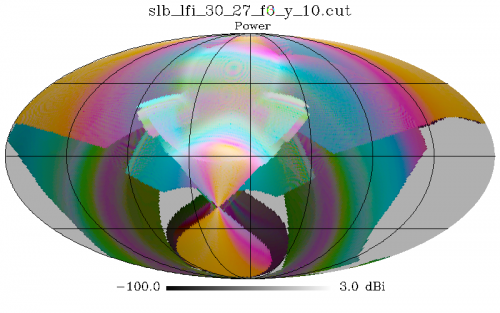
References[edit]
- Jump up ↑ The Planck-LFI flight model ortho-mode transducers, O. D'Arcangelo, A. Simonetto, L. Figini, E. Pagana, F. Villa, M. Pecora, P. Battaglia, M. Bersanelli, R. C. Butler, S. Garavaglia, P. Guzzi, N. Mandolesi, C. Sozzi, Journal of Instrumentation, 4, 2005-+, (2009).
- ↑ Jump up to: 2.02.1 Planck 2015 results. IV. LFI beams and window functions, Planck Collaboration, 2016, A&A, 594, A4.
- Jump up ↑ Planck 2013 results. IV. Low Frequency Instrument beams and window functions, Planck Collaboration, 2014, A&A, 571, A4
- Jump up ↑ Planck pre-launch status: The optical system, J. A. Tauber, H. U. Nørgaard-Nielsen, P. A. R. Ade, J. Amiri Parian, T. Banos, M. Bersanelli, C. Burigana, A. Chamballu, D. de Chambure, P. R. Christensen, O. Corre, A. Cozzani, B. Crill, G. Crone, O. D'Arcangelo, R. Daddato, D. Doyle, D. Dubruel, G. Forma, R. Hills, K. Huffenberger, A. H. Jaffe, N. Jessen, P. Kletzkine, J. M. Lamarre, J. P. Leahy, Y. Longval, P. de Maagt, B. Maffei, N. Mandolesi, J. Martí-Canales, A. Martín-Polegre, P. Martin, L. Mendes, J. A. Murphy, P. Nielsen, F. Noviello, M. Paquay, T. Peacocke, N. Ponthieu, K. Pontoppidan, I. Ristorcelli, J.-B. Riti, L. Rolo, C. Rosset, M. Sandri, G. Savini, R. Sudiwala, M. Tristram, L. Valenziano, M. van der Vorst, K. van't Klooster, F. Villa, V. Yurchenko, A&A, 520, A2+, (2010).
- ↑ Jump up to: 5.05.1 Fast Pixel Space Convolution for Cosmic Microwave Background Surveys with Asymmetric Beams and Complex Scan Strategies: FEBeCoP, S. Mitra, G. Rocha, K. M. Górski, K. M. Huffenberger, H. K. Eriksen, M. A. J. Ashdown, C. R. Lawrence, ApJS, 193, 5-+, (2011).
(Planck) Low Frequency Instrument
LFI Radiometer Chain Assembly
[LFI meaning]: absolute calibration refers to the 0th order calibration for each channel, 1 single number, while the relative calibration refers to the component of the calibration that varies pointing period by pointing period.
Line Of Sight
reduced IMO
Cosmic Microwave background
Full-Width-at-Half-Maximum
(Hierarchical Equal Area isoLatitude Pixelation of a sphere, <ref name="Template:Gorski2005">HEALPix: A Framework for High-Resolution Discretization and Fast Analysis of Data Distributed on the Sphere, K. M. Górski, E. Hivon, A. J. Banday, B. D. Wandelt, F. K. Hansen, M. Reinecke, M. Bartelmann, ApJ, 622, 759-771, (2005).
Operation Day definition is geometric visibility driven as it runs from the start of a DTCP (satellite Acquisition Of Signal) to the start of the next DTCP. Given the different ground stations and spacecraft will takes which station for how long, the OD duration varies but it is basically once a day.
Early Release Compact Source Catalog
(Planck) High Frequency Instrument
Data Processing Center

